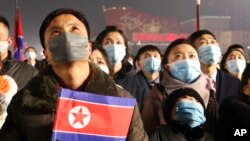North Korean leader Kim Jong Un vowed to dramatically boost production of nuclear warheads and to build a new long-range missile, according to year-end comments published by state media Sunday.
In an address at a major ruling party meeting a day earlier, Kim urged an all-out effort to develop “overwhelming military power” to counter what he said were hostile moves by the United States and its allies, according to a summary published by the Korean Central News Agency.
South Korea, Kim said, is a “clear enemy,” raising the need for North Korea to “exponentially” increase production of nuclear warheads, including tactical nukes.
Outside experts estimate that North Korea already has enough fissile material to build about 50 nuclear weapons, as well as a growing number of missiles that could be capable of carrying such warheads.
In his speech Saturday, Kim called for the development of an intercontinental ballistic missile with “rapid nuclear counterattack capability” – likely a reference to a solid-fueled ICBM that could be launched much more quickly than a liquid-fueled missile, experts said.
North Korea will also launch its first spy satellite soon, Kim added.
In a written statement, South Korea’s military said Kim’s comments “seriously undermine peace and stability” and warned “the Kim Jong Un regime will face an end if the North attempts to use nuclear weapons.”
The Korean Peninsula saw military tensions steadily worsen in 2022, as each side increased its displays of military strength and condemnations of the other.
Hours before details of Kim’s speech emerged, North Korea conducted its first missile launch of the new year.
North Korea launched a short-range ballistic missile into the sea off its east coast about 2:50 a.m. local time Sunday, according to South Korea’s military. A day earlier, the North fired three short-range ballistic missiles, capping an unprecedented year of launches.
North Korean state media said the Saturday and Sunday launches involved “super-large” artillery shells that can be loaded with tactical nuclear weapons that can reach anywhere in South Korea.
In separate statements, the U.S. and South Korean militaries condemned the launches as provocative and destabilizing.
In 2022, North Korea tested some 70 ballistic missiles, by far a record.
As a result of its testing flurry, North Korea can likely field missiles that fly faster and for longer distances, launch more quickly, and better evade the missile defenses of its foes, according to analysts.
In response, the United States and its allies have increased diplomatic and defense coordination and ramped up their own displays of military strength.
With each side blaming the other for raising tensions, it is not clear when the current cycle of provocations will end.
In the past, North Korea has often intentionally created a sense of crisis, seemingly in order to gain leverage ahead of negotiations with the United States.
However, North Korea in the past year has repeatedly stated it is not interested in talks and that it will never trade away its nuclear weapons.










